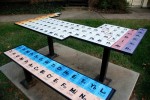
In
Popular Science, Bjorn Carey imagines a scenario in which all of the elements on the periodic table were present in the same location simultaneously:
Ramming the atoms together at 99.999 percent the speed of light—the top speed of particles in the Large Hadron Collider, at the CERN particlephysics lab near Geneva—might fuse a few nuclei, but it won’t make that cool Frankenstein element. More likely, they would meld into a quark-gluon plasma, the theoretical matter that existed right after the universe formed. “But they would last for a fraction of a second before degrading,” Tuckerman says. “Plus, you’d need 118 LHCs—one to accelerate each element—to get it done.”
The other approach, as explained by John Stanton, the director of the Institute for Theoretical Chemistry at the University of Texas, would be to toss a pulverized chunk of each element or a puff of each gas into a sealed container and see what happens. No one has ever tried this experiment either, but here’s how Stanton thinks things would play out: “The oxygen gas would react with lithium or sodium and ignite, raising the temperature in the container to the point that all hell would break loose. Powdered graphite carbon would ignite, too. There are roughly 25 radioactive elements, and they would make your flaming stew a little dangerous. Flaming plutonium is a very bad thing. Inhaling airborne radioactive material can cause rapid death.”
Once things calmed down, Stanton says, the result would be as boring as the atoms-only scenario. Carbon and oxygen would yield carbon monoxide and carbon dioxide. Nitrogen gas is very stable, and would remain as is. The noble gases wouldn’t react, nor would a few of the metals, like gold and platinum, which are mostly found in their pure forms. The things that do react will form rust and salts. “Thermodynamics wins again,” he says. “Things will always achieve equilibrium, and in this case that’s a mix of common, stable compounds.”
 In Popular Science, Bjorn Carey imagines a scenario in which all of the elements on the periodic table were present in the same location simultaneously:
In Popular Science, Bjorn Carey imagines a scenario in which all of the elements on the periodic table were present in the same location simultaneously:
No comments:
Post a Comment